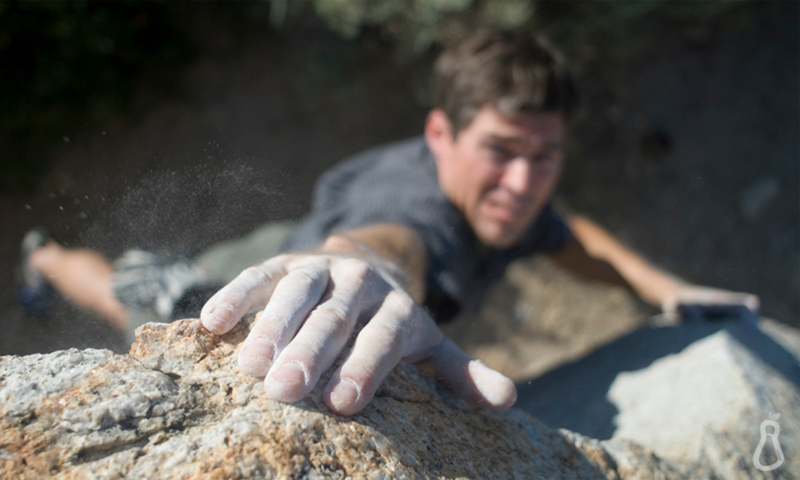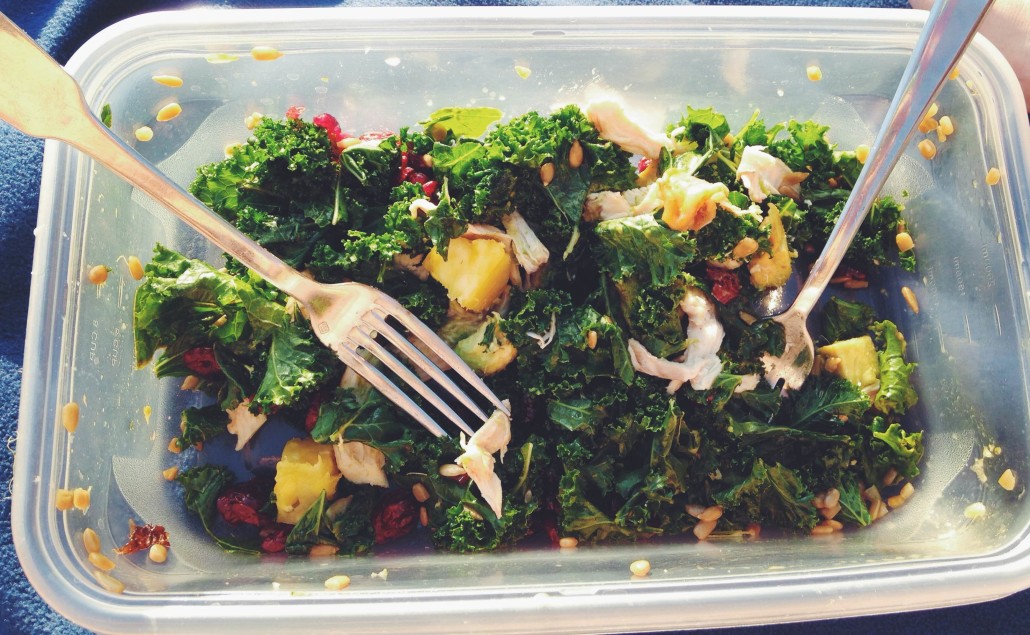A few weeks ago, my friend tweaked his finger. We weren’t entirely sure what he did to it, but he could feel a sharp pain in his palm when he isolated the finger.
I spent a few hours online trying to find a probable diagnosis and ultimately came across a great article on climbing.com called Finger Fixes.
This particular article was perfect because it outlined the different signs and symptoms of 3 very common finger injuries (A2 pulley, flexor tendon, and collateral ligament). This helped me formulate a recovery plan, but before I get into that, let’s start with the basics.
What are tendons?
Muscles tend to hog the spotlight when it comes to recovery and sports nutrition, but if you’ve ever injured a finger, then you know that your muscles are pretty useless without your tendons and ligaments.
Tendons are thick bundles of collagen that connect muscle to bone and allow movement, while ligaments are flexible bundles of collagen that connect bone to bone and protect your joints.
They have slightly different functions in the body, but they are both forms of connective tissue made up of collagen, elastin, proteoglycans (chains of sugars attached to proteins), and minerals like copper, manganese, and calcium.
Foods That Strengthen Your Tendons and Ligaments
Nutrient |
Food Sources |
Vitamin C |
Bell peppers, guava, kale, turnip greens, kiwi, broccoli, berries, oranges, grapefruit |
Manganese |
Clams, hazelnuts, pecans, walnuts, pumpkin seeds, chia seeds, flaxseeds, tofu, tempeh, lima beans, spinach, pineapple |
Vitamin B6 |
Chickpeas, salmon, chicken, turkey, potatoes, sunflower seeds, spinach, bananas |
Vitamin B12 |
Clams, trout, salmon, beef, eggs, fortified cereals, fortified soymilk |
Magnesium |
Spinach, almonds, peanuts, cashews, soymilk, black beans, avocado |
Zinc |
Oysters, beef, lobster, pork chop, baked beans, chicken, cashews, chickpeas |
The majority of connective tissue consists of a protein known as collagen. In order to make collagen, your body requires vitamin C and the mineral manganese.
Vitamins B6 and B12 support nerve function and aid in the formation of amino acids. Amino acids are the building blocks of protein, which are used to form muscles, tendons and ligaments.
These B vitamins are found mostly in animal products, but you can also get them in a multivitamin or B complex vitamin. If you choose to take a supplement, look for methylcobalamin (B12) and pyridoxal-5-phosphate (B6), the active forms of these vitamins.
Magnesium is a mineral that aids in muscle relaxation, bone formation, and protein synthesis. It can be found in a standard multivitamin, or taken by itself.
Zinc is another mineral that aids in protein synthesis and tissue formation, as well as immune support.
As you can see, consuming a variety of fruits and vegetables is the best way to ensure that your body is getting all the nutrients your tendons and ligaments need.
Finger Rehabilitation
Dr. J also recommends cutting back on your crimping, ditching the campus board, relying on comfrey cream, and resorting to acetaminophen if the pain is simply unbearable.
It’s best to avoid NSAIDS like ibuprofen and aspirin because they can damage the lining of your gut and weaken your immune system, which can delay healing. For more of Dr. J’s advice, visit his website.
**UPDATE** If you’re finding it difficult to include these foods in your diet, you can also try supplementing your diet with these nutrients by taking LigaPlex I (for maintenance), LigaPlex II (for acute injury), VitalProteins Collagen Peptides or SportsResearch Collagen Peptides (for maintenance or acute injury).
Finger-Fortifying Kale Salad
Ingredients:
- 1 large bunch of kale
- 1 pineapple, peeled and cubed
- 2 small avocados
- 1/4 cup sunflower seeds
- 1/4 cup dried tart cherries
- 1/4 cup olive oil
- 3 Tbsp lemon juice
- 1-2 Tbsp apple cider vinegar (optional)
- Handful of unsweetened shredded coconut
Instructions:
- Wash kale and remove stems from kale leaves.
- Rip kale leaves into small pieces and place in large bowl.
- Massage kale until leaves soften and color darkens.
- Add remaining ingredients, toss, and enjoy!
- Top with protein of choice, if desired.





My ligaments are very weak and my muscles are very tight what sort of nutrition would you suggest?
My son has severe tendonitis in his knee and elbows as well as his hands. It was caused by years of being bed ridden from migraines His migraines are finaly under control. We appreciate your info on strengthening with diet as he would tear if he tried to exexercise at this time. He also suffers from severe nausea which makes it difficult for him to drink shakes . I tthought maybe if we add fresh ginger to them.Is there any other suggestions you might have as his gut is a mess from years of medication. His goal is to get off all his meds some day.We know the body can heal it self given the right nutrients. Just need to get started. Thanks for sharing!
Hi Margie,
I’m so sorry to hear about your son’s medical troubles. If he has trouble digesting protein shakes, then it’s possible that he’s not producing enough stomach acid. Low stomach acid is often a symptom of a zinc deficiency, so it might be useful to check the essential minerals in his blood. As far as healing the rest of his gut, I highly recommend PeakBiotics (a probiotic) and Immunoglobulin powder to all of my clients. He might also respond well to LigaPlex, a supplement intended to help strengthen tendons and ligaments.
This is great, thanks!!
Your article was very informative however I have a direct question. Will protein bars (24 Grams) help with the recovery of a Left arm (dominant hand) tendon issue? Great Stuff in your articles and hopefully you will be able to answer me because I am desperate for help. Clint
I am sorry was in too much of a rush. I tweaked (in a bad way) lifting weights, that were not that heavy on that day. I can not remember which exercise I tweaked it on. Can no longer lift heavy because of immense pain radiating from the base of left elbow and I have swelling in the middle of my forearm. My doctor just send me for an X-ray.
Organic sour sop tea for migraines & to naturally heal digestive troubles. U can order organic on Etsy for the young boy with migraines. Also Vital Proteins Collagen Type ll for tendon repair 🙂
Very helpful for specially for old aged people in finding required food items.
Most helpful article for joint pains
GArlic and cabbage combined can relieve pain in ligaments / tendons – Garlic being anti-inflammatory and cabbage being a collagen food.. together they relieve aches.. over night..
I have damaged tendons from taking drugs (Levaquin). What do you recommend for healing connective tissue in general?
Hello. I recently suffered a torn Achilles’ tendon. I had surgery to repair. Looking for the right foods, vitamins and supplements that will aid in the healing process. Also have torn meniscus. Do these suggestions have the same effects?
Great article!
I injured my Achilles tendon on my right ankle and as it was healing I fell and feel damage to my left ankles Achilles as well I never had surgery as it wasn’t torn but I was told I had tendinitis some days or are better than others extensive walking bothers me but I do walk and work daily and wearing in the wrong and improper shoes bothers me I have to wear shoes with very good support, even in the house
Can you tell me what can I take to heal make my Achilles Tendons stronger
I try to follow a sensible diet I do take liquid vitamin supplements and also B 12 magnesium
Julia
this is very interesting information. Would you use garlic/cabbage combination internally or externally? Or possibly use it in both ways?
Maria
Hi Charity, in theory these vitamins and foods should aid in the recovery process, but research is very limited in this area, so it’s hard to say.
Hi Gene, I’m sorry to hear that. Healing connective tissue usually requires some form of physical rehabilitation along with the nutrients listed above. Have you tried supplementing your diet with some collagen peptides?
Hi Julie, I would suggest some form of wrap or taping that would provide added support to the tendon, potentially special shoes or shoe inserts designed for achilles injuries, and supplementation of collagen peptides since you’re already taking vitamin supplements and eating well. Massaging your calf muscles may also help relieve some additional pressure on the tendons. I hope you start to feel better soon!
I believe using these internally would have the most beneficial effect.
I have weak tendons on either side of my groin. Severe pain when I lift my legs. Please help..
Try a plant based diet.